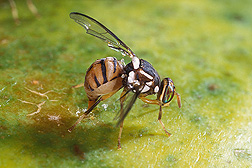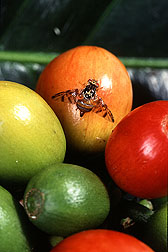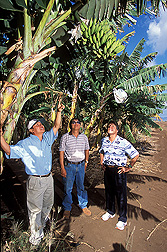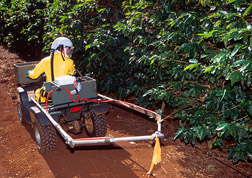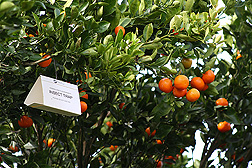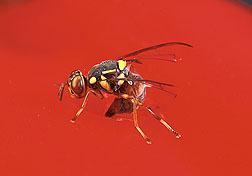Less Pesticide, Fewer Fruit Flies
|
|
California has put more than $500 million and tons of insecticides into eradicating exotic fruit flies wherever and whenever they’ve appeared in the state over the last 40 years.
Why such effort to control insects that are about the size of a kernel of corn? Because if just one species of exotic fruit fly, like the Mediterranean fruit fly—Ceratitis capitata, commonly called the “medfly”—became established, it could cost California more than $1.4 billion a year in lost markets, export sanctions, treatment costs, and reduced crop yields, in addition to the loss of 14,000 jobs.
A risk that big justifies the use a lot of insecticide. But in the last seven decades, California has been able to cut its pesticide use by as much as 8,000-fold and still keep these tiny but destructive pests from becoming permanent state residents by putting to work the results of the Agricultural Research Service’s fruit fly program.
Aloha, Fruit Flies
Many of the fruit fly control measures being used by California had their genesis in research from ARS’s U.S. Pacific Basin Agricultural Research Center (PBARC) in Hilo, Hawaii, and the agency’s Kika de la Garza Subtropical Agricultural Research Center in Weslaco, Texas.
Because Hawaii has been infested since the late 1800s by a variety of exotic fruit flies, including medfly, melon fly, oriental fruit fly, and Malaysian fruit fly, the islands are an ideal location for developing and testing control methods. There is no chance of further spread and there are lots of fruit flies to control.
Improved ways of producing sterile male fruit flies released to short-circuit the breeding cycle, new biocontrols such as augmentative releases of parasitic wasps, and better ways to manage crops to minimize fruit fly infestation are all techniques that have come from PBARC research. In particular, more effective and more species-specific lures and baits that have come from ARS research are what have made deep reductions in insecticide use possible in California and Florida.
|
|
Lessening the Load
“Back in the 1930s, California sprayed lead arsenate at a rate as high as 2 pounds of active ingredient (AI) per tree—about 260 pounds AI per acre—and still did not succeed in eradicating walnut husk fruit fly infestations,” explains Robert V. Dowell, program supervisor for the Integrated Pest Control Branch of the California Department of Food and Agriculture (CDFA). “Later, we used a combination of removing infested host trees and spraying DDT or diazinon at a rate of 2-4 pounds AI per acre, which was successful against the Mexican fruit fly. It was quite a load of pesticide on the environment, but it was the best we had at the time, and it had to be done.”
By the mid-1950s, ARS research allowed CDFA to switch from cover sprays to a lure/bait mixed with malathion at 0.5 pounds AI per acre, which eliminates fruit flies. Further ARS research from the 1960s to the 1990s showed that the amount of malathion used could be reduced to 0.2 pounds AI per acre and then down to 0.1 pounds AI per acre and still eradicate fruit fly infestations.
“Those bait drops were about 10-20 percent malathion and actually provided a lethal dose if the insects simply walked across the bait, which was good because the lure itself wasn’t very tempting for fruit flies to eat,” Dowell says.
In the 1990s, ARS developed a new bait that more readily attracted medflies, smelling more like a gourmet dinner to them.
|
|
Now the new bait is being combined with a more environmentally friendly insecticide, developed by Dow AgroSciences LLC, called “spinosad.” In ARS lab tests, it took only 5 parts per million of spinosad to kill medflies, and the compound is basically not lethal by contact, only by ingestion. The effective dose is as little as 0.00025 pounds AI per acre.
“What we do today is knock the population down with the bait plus spinosad and then flood the area with sterile males to disrupt the mating cycle of any stray medflies that might be left,” Dowell says. “Of course, ARS came up with the sterile male method too and has developed the diets and rearing techniques that make the technique economical and efficient.
“ARS has simply made it possible to keep medflies out of California and Florida for the past five decades,” Dowell summarized.
Areawide’s the Key
Medflies are not the only fruit fly species that the states are keeping at bay: Bactrocera species like the oriental fruit fly and melon fly are as big a threat.
“We started out fighting Bactrocera fruit flies the same way we did medflies—using cover doses of pesticides like diazinon,” Dowell recounts. “Then ARS research showed us how we could use less pesticide and still have eradication.”
In 2001, PBARC began the next major step in fruit fly control by developing an areawide integrated pest management (IPM) program in Hawaii. It combined all the techniques that ARS has developed over the years into a single program designed to use as little insecticide as possible but still stop the spread of fruit flies. This includes use of methyl eugenol for oriental fruit fly and cuelure for melon fly. These powerful parapheromones attract male fruit flies from far away so they can be removed from the population.
|
|
To eradicate two major genera of pest fruit flies, Bactrocera and Dacus, California is mixing methyl eugenol with a low dose of the insecticide Naled and a thickener and applying about 10 milliliters of the mixture to 600-900 sites per square mile, mostly telephone and utility poles. This program has been successful against 130 infestations, according to Dowell, using only 0.008 pounds AI/acre. That’s a 250-fold reduction in insecticide for these species.
And the results from ARS’s areawide IPM research have also allowed California to shrink the area around an infestation that has to be treated with ground spraying from a half-mile radius to an eighth-mile—a 94-percent reduction in area treated.
The State of California has been using methyl eugenol and cuelure as monitoring and detection agents and as a component in its Bactrocera eradication programs under special authority from the Environmental Protection Agency (EPA). There currently is no EPA registration for their general use as control agents by growers and homeowners. ARS has been using them in Hawaii as a biopesticide on farms and in home gardens under an EPA research permit as ARS, the University of Hawaii, and the Hawaii Department of Agriculture have been devising the areawide IPM program. (Details about this research are available at www.fruitfly.hawaii.edu.)
The areawide program has been so successful and stimulated such interest that several companies have filed applications with EPA for general end-use permits for methyl eugenol and cuelure as potential biopesticides for growers and gardeners.
|
|
Scentry Biologicals, Inc., of Billings, Montana, is one of the companies that has been supplying ARS with methyl eugenol and cuelure for use by farmers and gardeners in the experimental IPM program. Scentry applied for the general-use registration.
“If EPA approves the application, it will mean the areawide IPM program can be moved out of the research arena and into the commercial arena, where growers and gardeners will be able to purchase the product directly, which is what must ultimately happen if the Hawaii success is to continue,” explains Michael Whalen, president of Scentry.
Scentry’s new product would come in a gummy formulation that fits into a lure basket that is placed inside a fly trap. No liquids or mixing would be required.
The Fight Continues
ARS isn’t resting on its laurels. Roger Vargas, an ARS research entomologist at PBARC, and his colleagues are looking at ways to further reduce the amount of pesticide needed to control exotic fruit flies.
“We are testing a lure/bait called ‘SPLAT-MAT,’ which consists of SPLAT, a waxy emulsion matrix product that combines methyl eugenol or cuelure with low doses of spinosad as the toxicant,” explains Vargas. “SPLAT-MAT can be sprayed instead of confined to traps, and the waxy formulation makes it exceptionally long lasting and rainfast.” SPLAT-MAT attracts and kills only male fruit flies, so it is designated as a “male annihilation technique” (MAT). The product is being developed by ISCA Technologies and Dow AgroSciences.
“In addition to being more environmentally friendly, SPLAT-MAT offers some other great advantages: It can be applied by shooting it at telephone poles, tree trunks, or other surfaces with a high-power spray gun or even regular spray equipment. That speeds up delivery and eliminates the need to establish or replenish traps. And it lasts longer than gels currently used,” Vargas adds.
Protein baits and more effective lures that attract male or female fruit flies are also being developed by ARS for use within the SPLAT/spinosad basic formulation, promising even more effective fruit fly control products in the future.—By J. Kim Kaplan, Agricultural Research Service Information Staff.

This research is part of Plant Protection and Quarantine, an ARS National Program (#304) described on the World Wide Web at www.nps.ars.usda.gov.
To reach those mentioned in this article, contact Kim Kaplan, USDA-ARS Information Staff, 5601 Sunnyside Ave., Beltsville, MD 20705-5128; phone (301) 504-1637, fax (301) 504-1648.
"Less Pesticide, Fewer Fruit Flies" was published in the May/June 2007 issue of Agricultural Research magazine.







